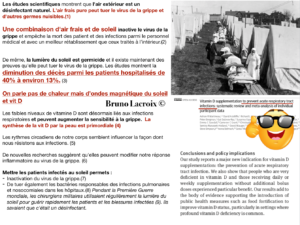
- Références
- (1) Aligne CA. Overcrowding and mortality during the influenza pandemic of 1918. Am J Public Health 2016 Apr;106(4):642–4. doi:10.2105/AJPH.2015.303018. .
- (2). Hobday RA and Cason JW. The open-air treatment of pandemic influenza. Am J Public Health 2009;99 Suppl 2:S236–42. doi:10.2105/AJPH.2008.134627.
- (3) Anon. Weapons against influenza. Am J Public Health 1918 Oct;8(10):787–8. doi: 10.2105/ajph.8.10.787.
- (4)Gruber-Bzura BM. Vitamin D and influenza-prevention or therapy? Int J Mol Sci 2018 Aug 16;19(8). pii: E2419. doi: 10.3390/ijms19082419.
- (5) Costantini C, Renga G, Sellitto F, et al. Microbes in the era of circadian medicine. Front Cell Infect Microbiol. 2020 Feb 5;10:30. doi: 10.3389/fcimb.2020.00030.
- (6) Sengupta S, Tang SY, Devine JC et al. Circadian control of lung inflammation in influenza infection. Nat Commun 2019 Sep 11;10(1):4107. doi: 10.1038/s41467–019–11400–9.
- (7) Schuit M, Gardner S, Wood S et al. The influence of simulated sunlight on the inactivation of influenza virus in aerosols. J Infect Dis 2020 Jan 14;221(3):372–378. doi: 10.1093/infdis/jiz582.
- (8) Hobday RA, Dancer SJ. Roles of sunlight and natural ventilation for controlling infection: historical and current perspectives. J Hosp Infect 2013;84:271–282. doi: 10.1016/j.jhin.2013.04.011.
- (9) Hobday RA. Sunlight therapy and solar architecture. Med Hist 1997 Oct;41(4):455–72. doi:10.1017/s0025727300063043.



